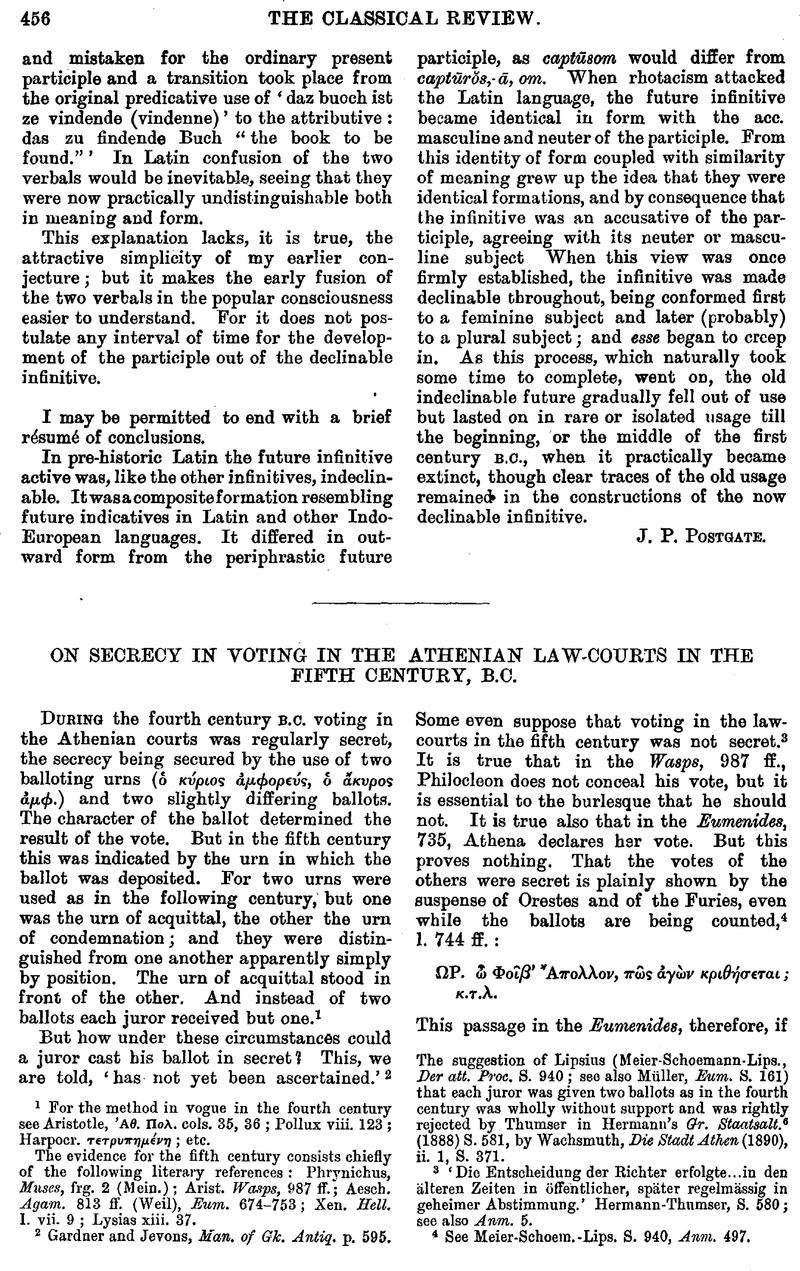No CrossRef data available.
Published online by Cambridge University Press: 27 October 2009

page 456 note1 For the method in vogue in the fourth century see Aristotle, Aθ. ΙΙολ. cols. 35, 36; Pollux viii. 123 Harpocr.τϛxτρυπημ⋯νη etc.
The evidence for the fifth century consists chiefly of the following literary references: Phrynichus, Muses, frg. 2 (Mein.); Arist. Wasps, 987 ff.; Aesch. Agam. 813 ff. (Weil), Eum. 674–753; Xen. Hell. I. vii. 9; Lysias xiii. 37.
page 456 note 2 Gardner and Jeyons, Man. of Ok. Antiq. p. 595.
The suggestion of Lipsius (Meier-Schoemann-Lips., Der att. Proe. S. 940Google Scholar ; see also Müller, , Eum. S. 161Google Scholar) that each juror was given two ballots as in the fourth century was wholly without support and was rightly rejected by Thumser, in Hermann's, Gr. Staatsalt.6 (1888) S. 581Google Scholar, by Wachsmuth, , Die Stadt Athen (1890), ii. 1, S. 371.Google Scholar
page 256 note 3 ‘Die Entscheidung der Richter erfolgte…in den älteren Zeiten in öffehtlicher, später regelmässig in geheimer Abstimmung.’ Hermann-Thnmser, S. 580; see also Anm. 5.
page 256 note 4 See Meier-Schoem.-Lips. S. 940, Anm. 497.
page 257 note 1 There is no evidence that the method of voting in the court of the Areopagus differed from that in vogue in the other courts in similar cases. The passage from the Eum, is admitted as evidence for the procedure in the other courts by Ross, (Arch. f. Philol. Suppl. I. (1831), S. 355)Google Scholar, Meier-Schoem, . -Lips, . (Der att. Proc.2, S. 937, 940)Google Scholar, Hermann-Thumser, (Gr. Staatsalt.6, S. 580)Google Scholar, Gilbert, (Gr. Staatsalt. i.2, S. 432)Google Scholar, etc.
The plural ![]() (1. 742) points to the use of two urns, one probably of acquittal, the other of condemnation, which was the arrangement familiar to Aesch. and his contemporaries (Agam. 815 f.). There is no reason, further, for doubting that each juror had but one ballot, though the Scholiast, 1. 749, supposes that two ballots were used, a black one and a white one. This suggestion is adopted by Sidgwick, who adds that this was the commonest method at Athens. Black and white beans were used in drawing lots for public officials, but it is extremely doubtful if the use of black and white ballots ever obtained in Athenian courts (see Meier-Schoem. - Lips. S. 940, Anm. 487).
(1. 742) points to the use of two urns, one probably of acquittal, the other of condemnation, which was the arrangement familiar to Aesch. and his contemporaries (Agam. 815 f.). There is no reason, further, for doubting that each juror had but one ballot, though the Scholiast, 1. 749, supposes that two ballots were used, a black one and a white one. This suggestion is adopted by Sidgwick, who adds that this was the commonest method at Athens. Black and white beans were used in drawing lots for public officials, but it is extremely doubtful if the use of black and white ballots ever obtained in Athenian courts (see Meier-Schoem. - Lips. S. 940, Anm. 487).
As a principle, secrecy in voting was familiar to the Athenians in the fifth century. Ostracism, established about 500 B.C., was by secret ballot. At the ![]() for admission to the phratry the Thiasôtai voted secretly (Dcmotionidai-inscr. 1. 77, quoted by Gilbert, Gr. Slaatsall.2, S. 215). At the
for admission to the phratry the Thiasôtai voted secretly (Dcmotionidai-inscr. 1. 77, quoted by Gilbert, Gr. Slaatsall.2, S. 215). At the ![]() conducted for the detection of illegally enrolled citizens the Deme-assembly voted secretly (Snidas:
conducted for the detection of illegally enrolled citizens the Deme-assembly voted secretly (Snidas:![]() ). So the
). So the ![]() voted secretly when performing certain judicial functions: ‘nur in Fällen die das persönMche Interesse Einzelnes betrafen’ (Schoemann-Lipsius, Gr. Alterth. i. S. 411). It is, therefore, an entirely reasonable inference that voting in the law courts was likewise secret.
voted secretly when performing certain judicial functions: ‘nur in Fällen die das persönMche Interesse Einzelnes betrafen’ (Schoemann-Lipsius, Gr. Alterth. i. S. 411). It is, therefore, an entirely reasonable inference that voting in the law courts was likewise secret.
page 457 note 2 Cf. Warr's trans, . Oresteia (1900), p. 22Google Scholar, ‘for her no hand but Fancy's fumbled in the void.’.
page 458 note 1 Philologus, Suppl. I. (1860), S. 566. The view entertained by Wilamowitz seems to be similar to that suggested by Ahrens: ‘Stein auf Stein in die Blnturne rollte, welche Troias Sturz bezeichnete; zur andern trat zmn Scheme nur mit leerer Hand der Richter. Klar ist der Entscheid.Google Scholar